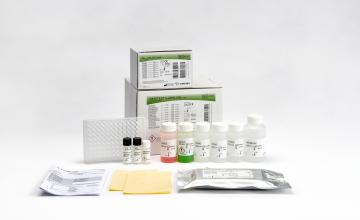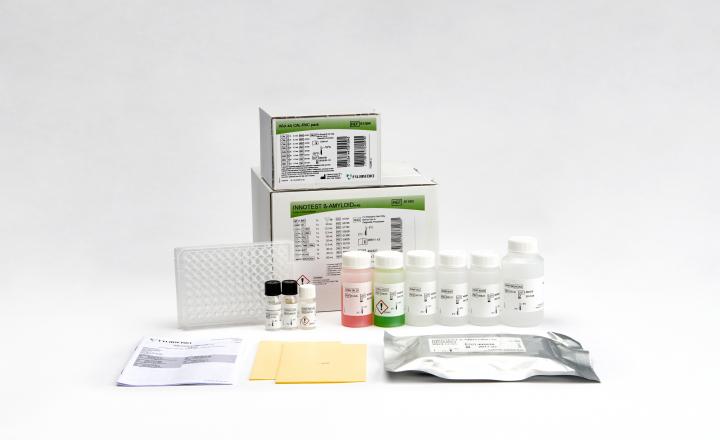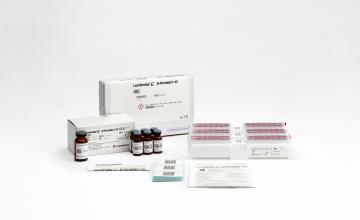INNOTEST® β-AMYLOID(1-40)
The INNOTEST β-AMYLOID(1-40) is a solid-phase enzyme immunoassay for the quantitative determination of β-amyloid(1-40) in human cerebrospinal fluid (CSF)1,2 in the clinical setting of dementia diagnosis.
Values for the 40- and 42-AA-long β-amyloid peptides can be expressed as a β-amyloid ratio, which is of particular use in patients in which an indeterminate CSF biomarker profile (based on 42-AA-long β-amyloid, TAU and Phospho-TAU) is observed1,2.
Product number 80462
Click here to navigate
- Contact sales for information
- Details
- Conditions of sale
- Citations
- Documentation
- Insights
- Product inquiry
- Related products
- Webinars
-
Details
Features & Benefits
-
User-friendly enzyme immunoassay, standard technology
- Generic and color-coded components
- Ready-to-use Calibrators reduce inter and intra run variation
- Run Validation Controls for assay run validation
- Sample dilution: 1:100 for CSF samples
- Sample volume: 75 µL diluted sample. Duplicate testing is strongly recommended and requires 2 x 75 µL diluted sample.
- Calibrator range: 7,8 to 1000 pg/mL
- This assay should be used in combination with the Aβ(1-40) CAL-RVC pack, article no. 81586 (RUO) and 80461 (CE).
* For research use only. Not for use in diagnostic procedures.
References
-
Dumurgier et al. Cerebrospinal fluid amyloid-ß 42/40 ratio in clinical setting of memory centers: a multicentric study. Alzheimers Res Ther. 2015; 7(1):30. doi: 10.1186/s13195-015-0114-5.
-
Slaets et al. Cerebrospinal fluid Aβ1-40 improves differential dementia diagnosis in patients with intermediate P-tau181P levels. J Alzheimers Dis. 2013; 36(4): 759-67.
Disclaimer
A license for the use of amyloid beta monoclonal antibodies contained in this product under patents US 6114133, US 7811769, and EP 0792458 has been obtained from Eli Lilly and Company.
-
-
Conditions of sale
To read the end user conditions of sale for this product please visit our Resource center.
-
Citations
The BIOZ badges associated with Fujirebio products include peer-reviewed citations derived from scientific studies using Fujirebio products. Please note that the peer-reviewed citations do not reflect the regulatory status of Fujirebio products. Users should refer to the specific product documentation and any (clinical) claims made therein in order to ensure compliant use. For each country or geographic region, users must verify the related regulatory status of the Fujirebio product.
-
Documentation
Browse regulatory documents for this product
Create a (free!) eServices account and start browsing all product documentation right away.
Multimedia
Watch product videos
Get a (free!) eServices account and benefit from full access to all our online resources.
Other documents
FileNeuroSig v6-0 macro for use with INNOTEST Neuro assays (vnd.ms-excel.sheet.macroEnabled.12, 214.10 kb)Extra informationThis macro is used with all Neuro INNOTEST assays for calculating the concentrations based on the OD values obtained by a plate reader.Get access to this section and more
Create a free eServices account now and instantly access multiple digital resources:
- Product documentation
- Selected scientific posters
- Product leaflets
- How-to videos and more…
-
Insights
Jul 23, 2025Fujirebio introduces its Neuro Expert Toolbox (NExT) at AAIC 2025
Fujirebio is introducing its Neuro Expert Toolbox (NExT) for the first time at AAIC 2025 (Alzheimer's Association International Conference®) in...
Nov 13, 2024Video - Alzheimer's awareness redefined
Follow the journey of the Sullivan family and leading Alzheimer’s Neurologist and Researcher Dr. David Greeley as they introduce and explain these...
Feb 20, 2024Publication - Serum and cerebrospinal fluid neurofilament light chains measured by SIMOA™, Ella™, and Lumipulse™ in multiple sclerosis naïve patients
We would like to draw your attention to a first publication on our Lumipulse® G NfL solution. In this article you will find a method comparison of CSF...
-
Product inquiry
-
Related products





















